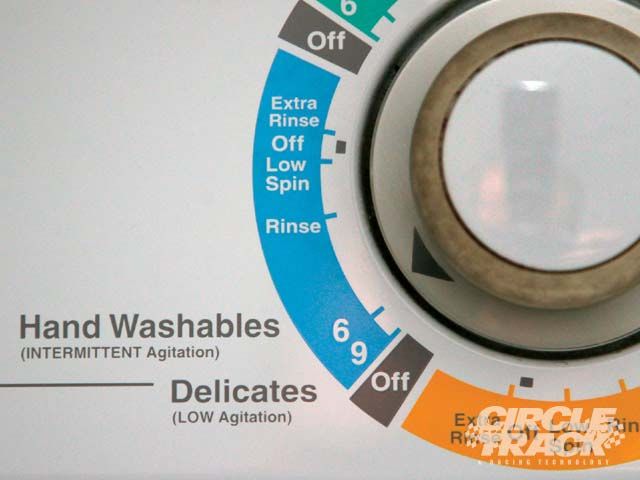
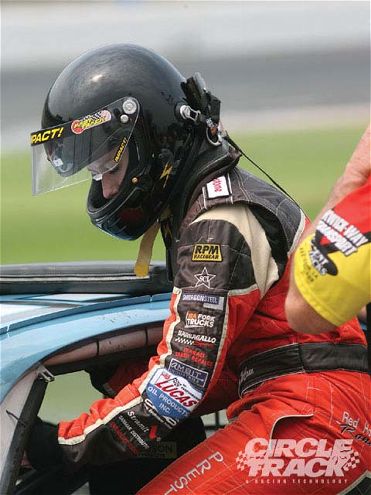 Keeping your firesuit clean, like Veronica McCann's, shown here, is the key to maximizing its performance in the event of a fire. Kevin Thorne
Keeping your firesuit clean, like Veronica McCann's, shown here, is the key to maximizing its performance in the event of a fire. Kevin Thorne
While each and every one of us know that a good firesuit is probably one of the most important pieces of safety equipment you can own, the proper care of your suit will make a significant difference in its performance when you need it most.
In order to understand the vital role proper care plays in the performance of your suit, we also must consider the type of suit or, more to the point, how the suit's manufacturer achieves fire retardancy. To do that, let's take a review of the different type of fire-retardant suits available today.
While there are numerous fire-retardant materials on the market, three that are often seen in the motorsports industry are fire retardant (FR) cottons, Nomex, and CarbonX. You may hear about other FR materials, such as Difco/PBI, Basofil, or Proban, but these tend to be used more in items such as firefighter suits and fire-retardant upholstery. But that doesn't mean you can't find them in the racing world, as Proban and PBI have both made a push into motorsports recently.
All of those FR materials perform admirably when tested, and in many cases, you will find that manufacturers offer suits made from several different materials or a combination of materials. For example, you can buy a custom suit made of either Nomex or CarbonX from Simpson Race Products.
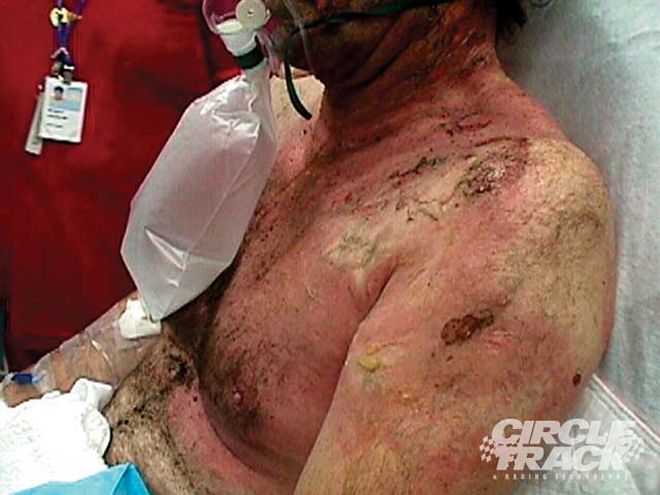 Improper care of your firesuit can lead to its failure. If your firesuit fails, you could end up with second-degree burns. Dr. Rick Malta
Improper care of your firesuit can lead to its failure. If your firesuit fails, you could end up with second-degree burns. Dr. Rick Malta
The quality of any fire-retardant material can be determined by looking closely at two measuring factors: Limiting Oxygen Index (LOI) and Thermal Protective Performance (TPP). LOI is the most commonly used measure for flame retardancy and refers to the amount of oxygen needed in the atmosphere to support combustion. If a fiber or fabric has an LOI of 25, that means that oxygen needs to be present in at least 25 percent of the air for the fabric to burn. Consequently, a higher rating equals more fire protection. Many fiber manufacturers achieve high LOI ratings by chemically treating their fabrics with a flame-retardant finish. The downside is those chemicals can be washed and worn off over time without proper care. You won't often see LOI in race suit literature, but it's an important factor in good fire protection.
On the other hand, TPP refers to the garment's ability to provide thermal protection when exposed to both direct flame and radiant heat while taking into account the length of time before a person is subject to second-degree burns. While that's a mouthful, TPP is the second most important number you need to know when firesuit shopping. The TPP rating is derived from a mathematical calculation performed with the results of a sophisticated test procedure that utilizes two different heat sources, sensors, and the fabric to be tested. The TPP rating is divided in half to determine the number of seconds until the human tissue reaches a second-degree burn. For example, if a particular fabric has a TPP rating of 35, it takes 17.5 seconds until a second-degree burn occurs in a flashover situation. See the chart to the right.
The only way to increase a TPP rating is through adding multiple layers. However, as you increase layers, suits get bulkier, and bulk does not equal comfort. Your goal in selecting a firesuit should be the balance of comfort with maximum protection.
Regardless of whether your suit is made of CarbonX, Nomex, Proban, FR cotton, or something else without the proper care its LOI and TPP can be adversely affected, especially over longer periods of time.
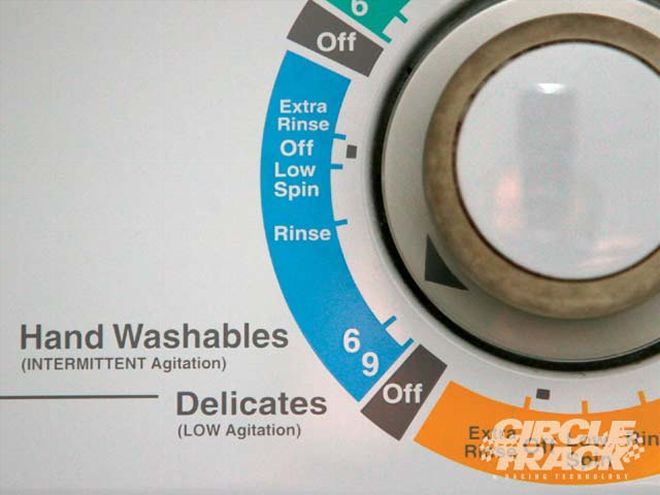 GForce Racing Gear recommends home laundering of its Nomex suits. Use the gentle or delicate cycle and cold water. Karen Bolles
GForce Racing Gear recommends home laundering of its Nomex suits. Use the gentle or delicate cycle and cold water. Karen Bolles
Proban & FR Cottons
Certain fabrics such as Proban can be washed using conventional methods. However, you shouldn't use detergents based on soap or detergents containing sodium silicate or metasilicate when the wash or rinse water hardness level is greater than 3 degrees Clark (45ppm calcium carbonate). What? In plain English, if you've hard, water don't wash your firesuit, get it professionally cleaned.
If fabrics have been incorrectly laundered, calcium or magnesium silicate/soap deposits will build up and interfere with the fabric's ability to retard flame and heat. The only way to remove it is with a commercial laundering and the use of an acid rinse, followed by alkaline neutralization. Not something you're going to do in Mama's laundry room.
Here's another one. Chlorine bleaches should not be used on FR Cottons or Proban as they chemically weaken the polymer. If a bleaching treatment is necessary, fabrics should be soaked in diluted cold hydrogen peroxide.
What about stains? Stains can be removed by pre-soaking using a biologically active detergent. However, when you wash it you should be doing so at a temperature of 60 degrees. Once you're finished the washing, you must completely remove excess detergent and other washing residue by rinsing thoroughly.
Proban-finished fabrics can also be dry cleaned, although a wet wash is recommended at intervals to prevent the gradual build up of deposits. A fresh solvent in the final rinse is also good to prevent the re-deposition of dirt removed during dry cleaning. Again, that all adds up to one thing: If you're interested in tackling the laundering of Proban or similar fabrics yourself, consult the manufacturer for specific instructions on how to get the best results.
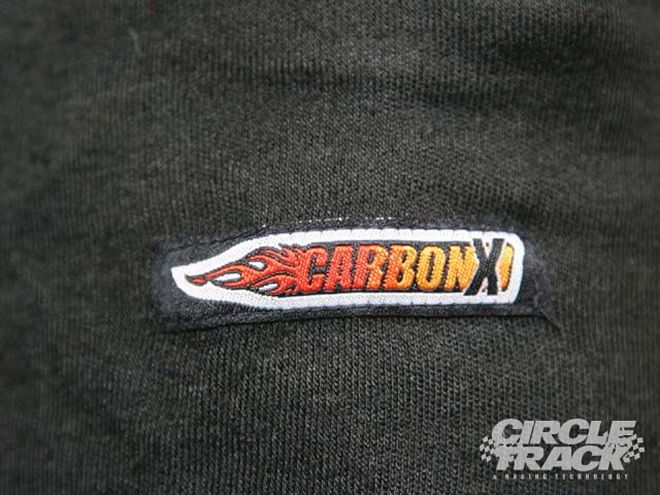 Whether it's Nomex or CarbonX, make sure to look for the tag when buying FR underwear. Karen Bolles
Whether it's Nomex or CarbonX, make sure to look for the tag when buying FR underwear. Karen Bolles
Nomex/CarbonX
Although laundering FR cottons such as Proban can be trickier because they are chemically treated materials, Nomex and CarbonX are a bit more straight forward. But before we get into that, understand that both Nomex and CarbonX are man-made engineered products.
Racing gear manufactured from Nomex is inherently flame-resistant, which means its resistance to flame is built into the fiber. It will not sustain combustion in air or melt when exposed to flame. Because Nomex carbonizes and becomes thicker when exposed to intense heat, it forms a protective barrier between the heat source and the skin. This unique reaction to intense heat provides valuable escape time when flash fires occur and protects drivers/crewmembers against them.
Like Nomex, CarbonX fabrics are based on patented blends of high-performance fibers that will not ignite, burn, char, shrink, or significantly decompose when exposed to intense flame, molten metal, arc flash, or high heat. CarbonX is the brand name behind the products produced by Chapman Thermal Products. In its raw form, CarbonX is a yarn created by spinning O-PAN (oxidized polyacrylonitrile) fiber with an Aramid strengthening fiber. The CarbonX yarn can then be converted into an array of fabrics ranging from woven fabrics, knitted fabrics, and non-woven felts.
Again, like Nomex, CarbonX yarns and fabrics will not burn when exposed to intense heat or flame. The actual fibers carbonize and then expand, eliminating any oxygen content within the fabric. Whether you choose CarbonX or Nomex, in order to maximize these fabrics' performance and protection, you need to properly care for them.
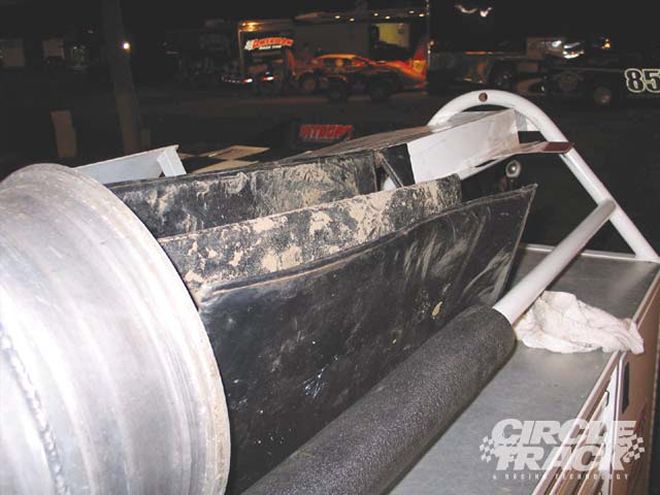 A track mat is a great way to keep your suit clean when working on the race car. Check out all the dirt on this one. Rob Fisher
A track mat is a great way to keep your suit clean when working on the race car. Check out all the dirt on this one. Rob Fisher
GForce Racing Gear's
Jeremy Curtis says that the company's Nomex suits are actually very easy to care for. "We recommend gentle machine washing in cold water and then hang the suit to dry," says Curtis. "Some people tell you to dry clean the suits, but without controlling the chemicals used in the dry cleaning process, we always say to machine wash to ensure preservation of the product."
Curtis makes an excellent point. If you choose dry cleaning, especially if you have a Proban or FR Cotton suit, the dry cleaner you choose should have experience in laundering fire-retardant fabrics. Simply put, you need to ask them if they have worked on these fabrics in the past. If they have, then great; if not, it's time to look for a new dry cleaner.
New Kid In Town
There are literally hundreds of soaps and detergents to choose from when it comes time to do the laundry but one new alternative on the market is the Molecule Technical Fabric Care System. Specially formulated for Nomex, CarbonX, Proban, and FR cotton fabrics, the system features a Wash Kit that includes the Molecule Wash, Molecule Spot Cleaner, and Molecule Refresher all for just under $42.
Step number one in the system is the Spot Cleaner which you use like a pre-wash for tough stains. Step number two goes to the Wash, which replaces your standard detergent when doing a load of firesuit laundry. Finally, the Molecule Refresher is designed for quick touch ups to keep everything fresh and clean. The Refresher is also great for deodorizing helmets. The folks at Molecule Labs say that the products have undergone extensive testing and remove even the toughest stains including grease, oil, and fuel. In fact, its tests show that firesuits treated with the Molecule system repel those same contaminants that are found all around your race car while still maintaining the breathability of the suit.
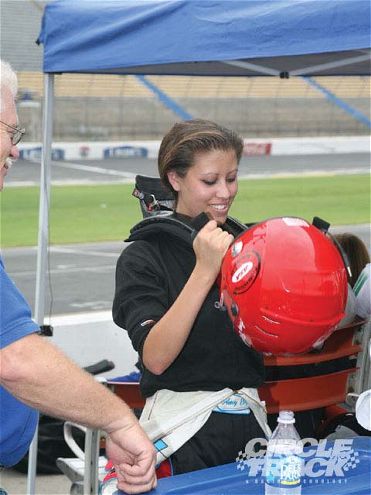 Driver Amy Elizondo uses Simpson's Nomex underwear to give her an extra layer of protection in the event of a fire. Kevin Thorne
Driver Amy Elizondo uses Simpson's Nomex underwear to give her an extra layer of protection in the event of a fire. Kevin Thorne
Keep It Clean
Aside from good laundering practices, one of the easiest ways to keep your firesuit in tip top condition is to pay careful attention to how you treat it. Grease, fuel, oil, and other contaminants found in and around the pits at any racetrack will have an adverse effect on your firesuit regardless of the type of fabric.
Let's say for example, you're performing the simple task of refueling your car in between the heat race and B-Main. Uncle Joe waddles by eating a hot dog (Uncle Joe supports his local track by buying food at the concession stand). Naturally, he bumps into you because he's not watching where he is going. Fuel splashes everywhere. You don't realize, however, that some of the gas splashed on, and subsequently soaked into, the right leg of your firesuit. Not a problem until...
You jump in the car for the B-Main and on lap 4 the unthinkable happens. An oil line comes off and fire erupts through the cockpit, catching the gas stain on your right leg. You manage to get out of the car, but the gas-soaked part of your suit has caught fire and you can feel intense heat building up faster and faster. Luckily for you, the track's emergency crew was quick to respond and knew what it was doing. You walk away just a tad singed. But what if it was slow? How long would your suit have held up?
As great as today's firesuits are at protecting us from the unthinkable, an accelerant of any type will impede their ability to do so. But what can you do about it? Simple, let somebody else fuel the car, change the fluid in the rear or whatever else. And if you're one of the many Circle Track readers who do all the work themselves, either by choice or by necessity, then at least take your suit off when you're working on the car. Hang it neatly in the trailer or in your truck.
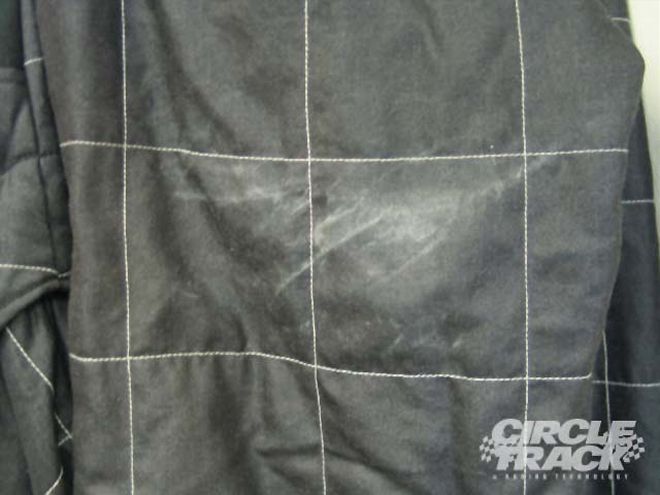 A stain like this might look like nothing, but if it's flammable, it can interfere with the performance of your firesuit. Rob Fisher
A stain like this might look like nothing, but if it's flammable, it can interfere with the performance of your firesuit. Rob Fisher
So, you don't have time to keep doing a quick change between heats, mains, and the feature? At the very least you should use some type of track mat. They're only about $25 and will help keep your firesuit clean when working under the car.
Finally, Mom always told you to wear clean undies, and the cleaning processes discussed for the firesuits applies to FR underwear as well. Like the suit, underwear comes in Proban-type FR cottons, Nomex, and CarbonX so launder those accordingly.
What? You don't wear FR underwear? Now, wait a minute, wearing fire-retardant underwear is a great way to increase the TPP rating of your two-layer suit without jumping up to a three-layer drag racing suit. For about $130, you can have a complete set of Nomex underwear (including socks). It will be money well spent.
In the end the maintenance and cleaning of your firesuit and related safety equipment is your responsibility. The better you take care of it, the longer it will last and the better it will perform. Now isn't that exactly what we all want from our safety equipment?
TPP VS. Second-Degree Burns: Simpson Race Products SFI rating TPP values Time to second-degree burns Typical use 3.2A/1 6 3 seconds Single-layer suit; entry-level 3.2A/5 19 9.5 seconds Double-layer driving suit 3.2A/10 38 19 seconds Land speed records 3.2A/15 60 30 seconds Top Fuel alcohol drag suit 3.2A/20 80 40 seconds Top Fuel alcohol Funny Car suit
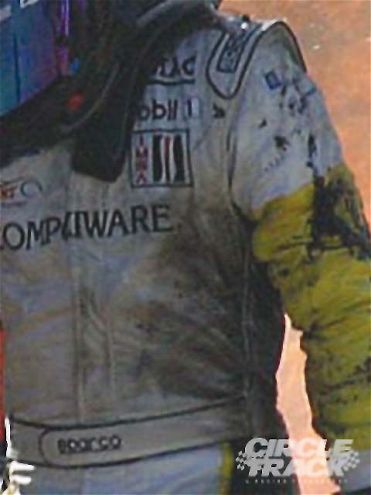 Even a well-maintained suit will show damage from an intense fire. SCR Archives
Even a well-maintained suit will show damage from an intense fire. SCR Archives
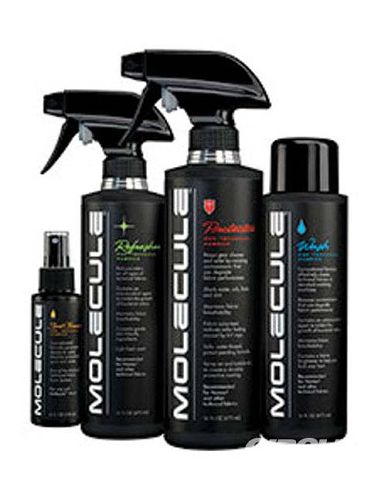 The Molecule Technical Fabric Care System is specially formulated to allow you to wash firesuits at home in your washing machine. Molecule Labs
The Molecule Technical Fabric Care System is specially formulated to allow you to wash firesuits at home in your washing machine. Molecule Labs
Ever Wonder How Fire-Retardant Cotton Fabrics Are Made?
Check out the four step process for making Proban, the popular FR cotton found in many racing firesuits. It's actually a chemical treatment that takes place at the finishing stage of the manufacture of cotton and cotton-blended textiles. It involves chemical impregnation.
1. Special fire-retardant chemicals whose molecules are sufficiently small and linear to penetrate the internal areas of the cotton fiber are introduced to the fiber during the finishing stage of its manufacturing process. These molecules are so small that some chemical will even be present in the spaces between the fibers.
2. The fabric is then dried in order to remove excess moisture and to prepare it for curing.
3. The dried fabric is cured with ammonia gas. This causes the small molecules to cross link and form a polymer. The polymer is then physically trapped and fixed in the core of each fiber of the cotton or cotton blend.
4. A final oxidation and neutralisation treatment completes the polymer fixation and removes any residual by-products. The cotton fabric is now officially Proban FR cotton and ready to be made into a firesuit.